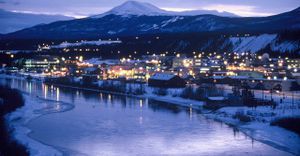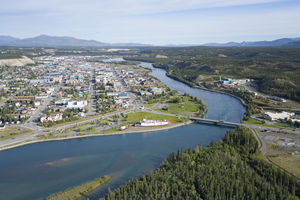Farlan: Difference between revisions
No edit summary |
|||
| Line 64: | Line 64: | ||
[[Category: Sayaffallah]] | [[Category: Sayaffallah]] | ||
[[Category:Cities]] | |||
Latest revision as of 01:09, 19 January 2017
Farlan is a city in Sayaffallah nestled in the foothills of the northernmost mountains of the country along the banks of the Iceamon River.
History
Early years
Farlan was founded in 1810 by a series of settlers moving into the area to fur trap and hunt in the extensive forests surrounding the foothills of the northernmost mountains of Sayaffallah. The original population on founding was 25 people but within a year that doubled and soon in 10 years time over 150 people lived within Farlan and a thriving community was created. Frequent raids by the Yasulit Tribe decimated the population of the town and forced many to move back to more populated stretches of Sayaffallah. The raids were a result of lingering hostility and suspicion between the native people and the settlers exacerbated by frequent settler incursions into native lands abutting their villages.
1830 saw the construction of a Fort built outside the city proper of Farlan and wooden palisade walls constructed around its perimeter. The wooden walls were frequently attacked by the natives in the area and in 1831 were overrun in the Massacre of Farlan which resulted in the population being lowered to only 20 people. A desperate plea was sent for help to the nearby city of Westernton a 6 hour horse ride away from Farlan and soon a garrison of 150 men was established and the fort was rebuilt and soon settlers began to arrive again. The garrison fought against the natives at least 3 or 4 times a month in fierce battles along the walls of the fort only to drive the natives away.
On March 15, 1841 the natives fought the Battle of Farlan and managed to burn the fort but at the end of the night the fort was still held by 50 of the garrison with over 100 of the garrison killed and only 10 dying on the side of the natives. The battle brought about significant changes and soon the population of Farlan once again increased as gold was found only 10 miles outside of the town in the foothills nearest Farlan. The population of Farlan by 1855 reached 650 people and the raids by the natives soon stopped completely as the native tribes migrated north into the mountains farther away from Farlan.
Gold rush
The Gold Rush of 1855 brought about new challenges primarily that of crime created by drunk miners in the town and soon the Police Department of Farlan was founded and a judge was elected by a public vote of the residents of Farlan to hear cases and to hand out justice. The popular punishment for everything from robbery to murder was death by hanging and soon crime dropped off completely as miners began to migrate away after filing their claims farther up into the mountain areas. But as miners left the town many of them were never heard of again as they entered into the mountains which are considered sacred burial grounds by the native peoples who live throughout the mountain areas. The decapitated bodies of miners would often be seen floating down the river and their heads could be seen following shortly afterwards in a horrific sight that shocked many within the town of Farlan.
The Gold Rush proved to be lucrative not just for the miners but for the growth of the city of Farlan as well and by 1869 the town had a population of 6,500 and saw the complete dismantlement of their walls to further allow for continued growth and property development. The first library was built in 1870 and soon the town had its own university under construction to provide a finishing education for the children of miners at a more affordable rate than what they could ever find in the neighboring town of Westernton.
Expedition of 1875
In 1874 the town voted to put together a military expedition into the surrounding mountains to root out the tribes living there and put an end to the massacres of miners that was ongoing up until this point. Over 750 were recruited to be a part of the expedition and they spent a year training and developing into soldiers and in the summer of 1875 after the last snow melted from the ground the soldiers set out for the nearby mountains. The soldiers climbed up the side of a mountain only to reach the summit and see an endless stretch of deep virgin forests and snowy valleys and more mountains past that and more valleys and mountains beyond that in an endless sea of mountains and valleys stretching as far as the eye could see. The soldiers camped for the night and around midnight a tremendous noise could be heard as a blizzard set on them and around two in the morning the first arrows pierced the tents of the soldiers and soon they were descended upon by over 3,000 natives in fierce combat.
Only 220 soldiers were able to escape and they ran rag-tag back to Farlan and told the villagers in near unanimity what had occurred. This sparked a buzz and soon the news was received of the defeat by those in neighboring Westernton who sent their more "professional" garrison of 4500 soldiers to Farlan to accompany them in marching back into the mountains to clear out the villages once and for all. This time they went through the forests and came upon a deserted village which they ransacked and destroyed. They then went over a ridge and came upon more virgin forest and came to a village full of women and children whom they massacred and the village was burned. Their second night they climbed up a ridge and camped within the confines of a cave. It was at 4 in the morning that the sounds of rocks could be heard as the entrance to the cave was completely covered over by rocks trapping the men inside. As the men went inside they came across torch lit areas and soon were set upon by over 12,000 of the native tribes best fighters and all were killed except for one man who hid in the entrance area among the fallen rocks. This one man was captured and the natives decided to send him to Farlan with an escort of 6,000 troops. The 6000 natives in full war paint descended upon Farlan and destroyed several buildings before turning and running out of the town and into the nearby forest.
The one man who survived told the story of what happened and that ended the Expedition of 1875 once and for all.
Joining Sayaffallah and economic downturn
In 1920 the town by now had a population of 12,500 and formally petitioned to join the nation of Sayaffallah which was granted and they became an integral part of the country. In 1925 the town suffered an outbreak of influenza which swept through the town and necessitated the building of a sanitarium and general hospital which was put into place almost immediately after the outbreak began. The outbreak of influenza not just curbed the population substantially down to 9,000 it also served to slow the economy of Farlan greatly with many moving out of the town and others simply moving away for the time being.
In 1944 the town saw a resurgence as many industries began to develop and thrive taking advantage of the river flowing through the town as a way of strengthening the local economy. Clothing and textile mills were opened and soon the population began to recover significantly back to its pre-influenza numbers. By 1950 the town was seeing an influx of more immigrants and the town's popular Latin District near the river was started.
Life in Farlan
Geography
Farlan is located in a subarctic zone in the foothills of the northernmost mountains of Sayaffallah. In the winter they experience heavy snowfall and in the summer they experience moderate temperatures with an absence of humidity in the air. Significant areas around the city are virgin forests covering vasts stretches of areas around the city limits providing rich oxidation to the atmosphere of Farlan.
Economy
The primary areas of the economy today in Farlan are that of Tourism and Fishing and Textiles. Over 30% of clothing made in Sayaffallah is made in the mills of Farlan to this day. The economy of Farlan has developed and changed over the years, to this day uranium and gold mining remain a significant mainstay of the local economy and a growing tourist sector is exploiting these industries to show tourists how nuclear weapons are manufactured at the uranium extraction stage which has brought tourists ranging from crack pot totalitarian dictators to young children wondering how they can blow up their house during their next temper tantrum.
Transport
Farlan is connected to the main highway grid through a 36 mile unpaved connector road which links the city of Farlan directly to the national transportation grid in Sayaffallah. The city itself has rejected numerous attempts to see direct highway links and even railroads to their city as it would destroy the virgin forests that surround Farlan.
Farlan does have an international regional airport which serves destinations across Sayaffallah and is equipped to handle international flights as well. The airport sees typically 30 flights a day and only 10 flights during the weekends when travel and airport services are a bit slower. Local ordinances and regulations prohibit flights during the hours of 8pm to 9am so as to minimize noise disruption for those trying to sleep in the city of Farlan. Typically during the winter flights are delayed by no more than 30 minutes usually because of deicing considerations due to the heavy snowfall and significant cold temperatures.
The river itself serves as a vital waterway for boaters and is deep enough and wide enough that pleasure yachts can be seen during summer months cruising up and down the river. However in the winter the river freezes solid and no boats are permitted to even attempt transiting through the river zone after an accident in 1966 left 30 people dead as a river ferry attempted to travel from the southernmost areas of the river up to Farlan only to capsize 5 miles outside of Farlan in the freezing waters. This means that in the winter time the river is a frequent destination for hockey enthusiasts as the local professional team changes venues and plays outdoors on the river with spectator seating provided in large segments on both banks of the river.
Sports teams
- Hockey: Farlan Icemen
- Soccer: Farlan Warriors
- Football: Farlan Maniacs
Population
Current population as of 2016 is 39,200.

